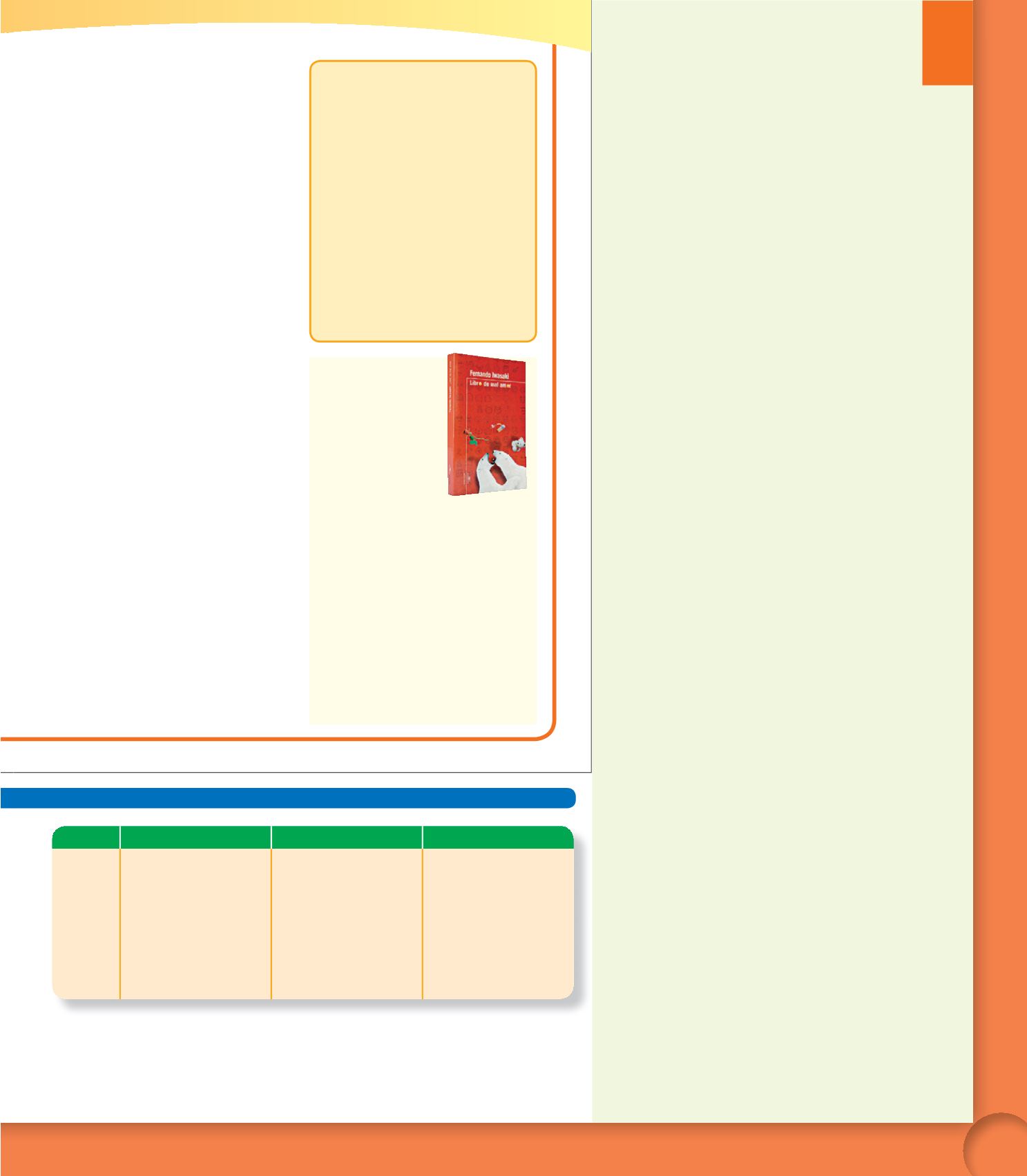

113
Escribe
■
Redacta una primera versión de la reseña.
Utiliza las notas que escribiste y sigue estas
recomendaciones:
– El resumen de la novela debe ser breve,
pero tiene que contener los elementos
esenciales para que el lector se haga una
idea clara del argumento. Obviamente, no
puedes desvelar el final.
– El comentario crítico debe recoger tu
opinión sobre la historia y los personajes,
y también puedes valorar el estilo literario,
comparar la obra con otras que hayas
leído, etc.
Vocabulario útil
la alusión
allusion
la imagen
image
la ironía
irony
el paralelismo
parallelism
la parodia
parody
el punto de vista
point of view
el ritmo
rhythm
ágil
agile
entretenido(a)
enjoyable
lento(a)
slow
magnífico(a)
magnificent
monótono(a)
boring
recomendable
advisable
sorprendente
amazing
Revisa
■
Intercambia tu reseña con tu compañero(a)
y revisa la suya. Fíjate en estos aspectos:
– ¿Te has hecho una idea clara de la novela?
– ¿Queda clara la opinión de tu
compañero(a) sobre la novela?
– ¿El texto está redactado de manera clara y
comprensible?
– ¿Se repiten mucho algunas palabras?
– ¿Tiene algún error gramatical, por ejemplo,
en el uso del indicativo y del subjuntivo?
¿Tiene alguna falta de ortografía?
■
Devuelve la reseña a su autor(a) con tus
sugerencias y revisa la tuya teniendo en cuenta
sus comentarios. Modifica lo que creas
necesario y pásala a limpio. Si quieres, puedes
incluir la imagen de la cubierta del libro.
Comparte
■
Lee tu reseña a la clase. ¿Alguno de tus
compañeros(as) ha leído esa novela?
¿Comparte tu opinión sobre ella?
■
Después de escuchar todas las reseñas,
comenta con tus compañeros(as) qué novela(s)
te gustaría leer y por qué. Pueden publicarlas
en un blog.
Libro de mal amor
Fernando Iwasaki
Novela
Editorial Alfaguara
Madrid, 2007
N.º de páginas: 180
Libro de mal amor
es la historia de los
fracasos amorosos de un joven que,
para alcanzar a la mujer de sus sueños,
se hace deportista, patinador, político,
vegetariano, judío y experto en
ballet
.
El joven es un antihéroe que se vuelve
camaleónico en su intento desesperado
de conquistar a las mujeres.
Es un libro muy entretenido que, con mucho
humor, narra diez fracasos amorosos
a cual más divertido. Con un estilo sencillo
y muchos juegos de palabras, este libro
es muy accesible para los adolescentes
a los que va dirigido. En mi opinión es una
lectura muy recomendable.
Unit
6
Escribe
.
Emphasize to students the importance of using
precise vocabulary. Correct usage of appropriate
words will make their review sound professional
and knowledgeable, as well as clear and to
the point. Encourage students to use both the
Vocabulario útil
on this page and the
Repaso de
vocabulario
on page 346 as reference.
.
Remind students that they should include a
critical evaluation of the book. This critique
usually contains reactions to the novel, describes
how it could be improved, comments on the
overall successes and failures of the book, and
analyzes how well the book has achieved its
goal. Encourage students to cite specific
examples or sections from the novel to support
their arguments.
Revisa
.
Ask students to read through their own text
before they exchange it with a classmate. Have
students try to look at their text from the point
of view of someone who has not read the book
and who is trying to decide whether to read it or
not. Tell students to make sure their book review
addresses important points in the novel, includes
some of the key events and provides examples,
and offers a critique of the book.
Comparte
.
If time allows, have a whole-class discussion
about the types of novels students have chosen.
Is there a trend among students? What motivates
them to want to read a particular book?
Evaluation
.
Distribute copies of the rubric to students and
discuss the evaluation criteria. Ask students
to refer to the rubric as they prepare their
writing and as they evaluate their classmates’
book reviews.
Una reseña
ESCRITURA
Content
Organization
Conventions
5 points Includes all necessary
information about
the book. Provides
a well-supported
recommendation.
Accurate, rich, and
purposeful word
choices.
Follows the suggested
format. Effective use of
transitions and logical
sequencing. Conclusion
binds review together.
Few, if any, errors in
spelling, punctuation,
grammar, and usage.
Excellent command of
the Spanish language.
345
Book 4 Unit 6


















